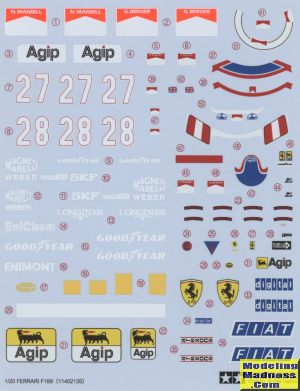
| KIT #: | 20024 |
| PRICE: | 1620 yen (1800 yen SRP) |
| DECALS: | Two options |
| REVIEWER: | Scott Van Aken |
| NOTES: | 1990 release |

| HISTORY |
The Ferrari 640 (also known as the Ferrari F1-89) was the Formula One racing car with which the Ferrari team competed in the 1989 season. It was driven by Britain's Nigel Mansell, in his first season with the team, and Austria's Gerhard Berger.
The car was designed by John Barnard, and it was the first Ferrari he was responsible for designing. It sported a sharp nose, with a narrow monocoque and bulging side-pods designed to house the radiators with maximum aerodynamic efficiency. It originally had two small air intakes either side of the driver, but from the fourth race of the season in Mexico a more conventional large air intake above and behind the driver was specified.
Barnard, who had joined Ferrari from McLaren at the end of the 1986 season, had begun designing the car in 1987 with the intent on it being used during the 1988 season. However, continual problems with the car's revolutionary semi-automatic gearbox saw the team forced to use the turbocharged F1/87/88C in 1988, with the car's debut pushed back to 1989, the first year of FISA's 3.5 Litre atmospheric formula where turbos were banned.
The 1989 Portuguese Grand Prix (formally the XXIII Grande Premio de Portugal) was a Formula One motor race held at the Autódromo do Estoril in Estoril, Portugal on 24 September 1989. The 71-lap race was the thirteenth of the 1989 Formula One season. It was won by Gerhard Berger to take his first, and only, victory of the season for Ferrari. Alain Prost finished in second place for McLaren, strengthening his championship chances after his team-mate and rival Ayrton Senna had been involved in a collision with Ferrari driver Nigel Mansell which resulted in them both retiring. Mansell had just been black flagged at the time of incident for reversing back into his pit box after overshooting it during a stop. The podium was completed by Stefan Johansson, who took both his last and Onyx's only podium, and also Onyx's last points.
| THE KIT |

| CONCLUSIONS |
If I were going to suggest a first 1/20 F.1 kit, this would be a good one. The kit is complex enough to satisfy, yet does not require a lot of fussy painting. My limited experience with Tamiya F.1 kits has shown them to be excellent builds that result in very nice models. The older kits like this are inexpensive even when new78, reissued with some frequency, and are easy to find on the second hand market.
| REFERENCES |
https://en.wikipedia.org/wiki/Ferrari_640
https://en.wikipedia.org/wiki/1989_Portuguese_Grand_Prix
May 2017 Copyright ModelingMadness.com. All rights reserved.
If you would like your product reviewed fairly and fairly quickly, please
contact
the editor
or see other details in the
Note to
Contributors.
Back to the Main Page
Back to the Review Index Page
Back to the Previews Index Page